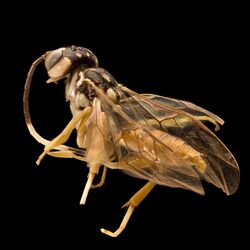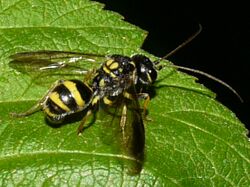Biology:Trigonalidae
| Trigonalidae | |
|---|---|

| |
| Orthogonalys pulchella | |
| Scientific classification | |
| Domain: | Eukaryota |
| Kingdom: | Animalia |
| Phylum: | Arthropoda |
| Class: | Insecta |
| Order: | Hymenoptera |
| Superfamily: | Trigonaloidea |
| Family: | Trigonalidae Cresson, 1887[1] |
| Genera | |
|
See text
| |
| Synonyms | |
|
Trigonalyidae Krieger, 1894 | |
Trigonalidae is one of the more unusual families of hymenopteran insects, of indeterminate affinity within the suborder Apocrita (though sometimes believed to be related to the Evanioidea), and presently placed in a unique superfamily, Trigonaloidea, and the only extant taxon in the superfamily. The other putative related taxon is the extinct family Maimetshidae, known from the Cretaceous period.[2] Trigonalidae are divided into 2 subfamilies; Orthogonalinae and Trigonalinae. These wasps are extremely rare, but surprisingly diverse, with over 90 species in 16 genera, and are known from all parts of the world.[3][4] It is possibly the sister group to all Aculeata.
Ecology
What little is known about the biology of these insects indicates a remarkably improbable life history: in nearly all known species, females lay thousands of minute eggs, "clamping" them to the edges of, or injecting them inside leaves. The egg must then be consumed by a caterpillar. Once inside the caterpillar, the trigonalid egg either hatches and attacks any other parasitoid larvae (including its siblings) in the caterpillar, or it waits until the caterpillar is killed and fed to a vespid larva, which it then attacks. If the caterpillar is neither attacked by another parasitoid nor fed to a vespid, the trigonalid larva fails to develop. Therefore, they are parasitoids or hyperparasitoids, but in a manner virtually unique among the insects, in that the eggs must be swallowed by a host, and even more unusual in that there may be an intermediate host. A few species are known exceptions, which directly parasitise sawflies.[5]
Nomenclature
The name of this family has also been spelled "Trigonaloidae" and "Trigonalyidae". These are unjustified emendations of the name and incorrect under Article 29.5 of the ICZN.[6][7][note 1] Despite this, some authors have continued to use the latter, "Trigonalyidae" spelling.[8][9]
Taxonomy
The fossil record of the family is poor, and there are no confirmed members of the family prior to the Cenozoic, with the oldest being from the Ypresian Eocene Okanagan Highlands in western North America.[10] A possible specimen is known from the mid-Cretaceous Burmese amber of Myanmar, but this differs substantially from modern members of the family, and may belong to the stem-group.[11]
Genera
Trigonalidae includes the following genera:
- Afrigonalys
- Bakeronymus
- Bareogonalos
- †Eotrigonalis
- Ischnogonalos
- Jezonogonalos
- Lycogaster
- Mimelogonalos
- Nomadina
- Orthogonalys
- Pseudogonalos
- Pseudonomadina
- Seminota
- Taeniogonalos
- Teranishia
- Trigonalys
- Xanthogonalos
References
- ↑ Synopsis of the families and genera of the Hymenoptera of America, north of Mexico, together with a catalogue of the described species, and bibliography. ET Cresson, Transactions of the American Entomological Society …, 1887
- ↑ "Trigonaloidea". https://eol.org/pages/2723465/names.
- ↑ Trigonalidae Website
- ↑ Carmean, David; Kimsey, Lynn (1998-01-01). "Phylogenetic revision of the parasitoid wasp family Trigonalidae (Hymenoptera)" (in en). Systematic Entomology 23 (1): 35–76. doi:10.1046/j.1365-3113.1998.00042.x. ISSN 1365-3113. Bibcode: 1998SysEn..23...35C.
- ↑ A., Triplehorn, Charles (2005). Borror and DeLong's introduction to the study of insects. Johnson, Norman F., Borror, Donald J. (Donald Joyce), 1907-1988. (7th ed.). Belmont, CA: Thompson Brooks/Cole. ISBN 9780030968358. OCLC 55793895.
- ↑ Engel, M.S.; Arkady, L.S. (2020-01-31). "On the spelling of family-group names based on the genus Trigonalys Westwood (Hymenoptera: Trigonalidae versus Trigonalyidae)" (in en). Entomologist's Monthly Magazine 156 (1): 58–60. doi:10.31184/M00138908.1561.3989. ISSN 0013-8908. https://www.ingentaconnect.com/content/10.31184/M00138908.1561.3989.
- ↑ Aguiar, Alexandre P. et al. (30 August 2013). "Order Hymenoptera. In: Zhang, Z.-Q. (Ed.) Animal Biodiversity: An Outline of Higher-level Classification and Survey of Taxonomic Richness (Addenda 2013)". Zootaxa 3703 (1): 51. doi:10.11646/zootaxa.3703.1.12. PMID 26146682.
- ↑ Chen, Hua-Yan; Hong, Chun-Dan; van Achterberg, Cornelis; Pang, Hong (12 March 2020). "New species and new records of Trigonalyidae (Hymenoptera) from Tibet, China". ZooKeys (918): 83–84. doi:10.3897/zookeys.918.49729. PMID 32210666. Bibcode: 2020ZooK..918...83C.
- ↑ Zhang, Bing-Lan; Yan, Cheng-Jin; van Achterberg, Cornelis; Peng, Yan-Qiong; Chen, Hua-Yan (29 April 2022). "Integrated taxonomy unveils new species of Trigonalyidae (Insecta, Hymenoptera) from Yunnan, China". Journal of Hymenoptera Research 90. doi:10.3897/jhr.90.80150. https://zenodo.org/records/6508930/files/JHR_article_80150.pdf. Retrieved 11 February 2023.
- ↑ Archibald, S. B.; Rasnitsyn, A. P.; Brothers, D. J.; Mathewes, R. W. (2018). "Modernisation of the Hymenoptera: ants, bees, wasps, and sawflies of the early Eocene Okanagan Highlands of western North America". The Canadian Entomologist 150 (2): 205–257. doi:10.4039/tce.2017.59. ISSN 0008-347X.
- ↑ Zhang, Qi; Rasnitsyn, Alexandr P.; Wang, Bo; Zhang, Haichun (2018-12-01). "Hymenoptera (wasps, bees and ants) in mid-Cretaceous Burmese amber: A review of the fauna" (in en). Proceedings of the Geologists' Association 129 (6): 736–747. doi:10.1016/j.pgeola.2018.06.004. ISSN 0016-7878. Bibcode: 2018PrGA..129..736Z. https://www.sciencedirect.com/science/article/pii/S0016787818301044.
Notes
- ↑ ICZN Code 29.5. Maintenance of current spellings. If a spelling of a family-group name was not formed in accordance with Article 29.3 but is in prevailing usage, that spelling is to be maintained, whether or not it is the original spelling and whether or not its derivation from the name of the type genus is in accordance with the grammatical procedures in Articles 29.3.1 and 29.3.2.
Wikidata ☰ Q148039 entry
 |


